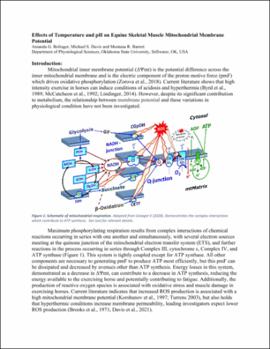| dc.contributor.author | Bolinger, Amanda G. | |
| dc.contributor.author | Barrett, Monica R. | |
| dc.date.accessioned | 2022-05-09T14:28:06Z | |
| dc.date.available | 2022-05-09T14:28:06Z | |
| dc.date.issued | 2022-05-06 | |
| dc.identifier | oksd_bolinger_HT_2022 | |
| dc.identifier.uri | https://hdl.handle.net/11244/335618 | |
| dc.description.abstract | Despite its significant contribution to metabolism, the relationship between membrane potential ([Delta][Psi]mt) and the physiological extremes of hyperthermia and acidosis has not been investigated. This study uses high-resolution respirometry (HRR) to test the hypothesis that conditions of hyperthermia and acidosis will result in decreased mitochondrial membrane potential. | |
| dc.description.abstract | Mitochondria were isolated from fresh semitendinosus muscle biopsies acquired from five Thoroughbred horses. Isolated mitochondria from these biopsies were analyzed using HRR to monitor oxygen consumption and relative changes in [Delta][Psi]mt (using TMRM). Assays will be conducted at simulated baseline physiological conditions (38 degrees C, pH = 7.0) as well as all other combinations of two temperatures (38 degrees C or 43 degrees C) and two pH levels (6.5 or 7.0). ANOVA two factor with replication, with the horse as repeating variable, was used to analyze the resulting data. P<0.05 was considered significant | |
| dc.description.abstract | Hyperthermia and acidosis resulted in decreased [Delta][Psi]mt both individually and in combination with each other during non-phosphorylating and phosphorylating respiration, although by different magnitudes. Acidosis decreased oxygen consumption during non-phosphorylating and phosphorylating respiration, but hyperthermia had no effect. Oxygen consumption per unit of [Delta][Psi]mt (JO2/[Delta]TMRM) was significantly increased by hyperthermia in both states, but acidosis only affected maximal phosphorylating respiration | |
| dc.description.abstract | The variations in how hyperthermia and acidosis each affected [Delta][Psi]mt and oxygen consumption suggests that they affect the Electron Transfer System (ETS) in different ways. The oxygen results of this study are in direct contrast to previous studies but can be explained by JO2/[Delta]TMRM results which likely show that acidosis inhibited respiration through complex I while hyperthermia increased membrane permeability. This study also demonstrates that ROS production is likely the result of inefficiencies in the ETS rather than proportionate to respiration. This study allows for the observation of comparative differences in membrane potential, but further calibration assays will be required to assign specific voltage across the inner membrane. | |
| dc.description.abstract | Although it is likely that they affect mitochondrial function in different ways and to varying degrees, it almost certainly results in decreased ATP synthesis, contributing to the development of fatigue in exercising horses. Understanding how hyperthermia and acidosis affect [Delta][Psi]mt illustrates how they may contribute to the development of fatigue in exercising horses. | |
| dc.format | application/pdf | |
| dc.language | en_US | |
| dc.rights | Copyright is held by the author who has granted the Oklahoma State University Library the non-exclusive right to share this material in its institutional repository. Contact Digital Library Services at lib-dls@okstate.edu or 405-744-9161 for the permission policy on the use, reproduction or distribution of this material. | |
| dc.title | Effects of temperature and pH on equine skeletal muscle mitochondrial membrane potential | |
| osu.filename | oksd_bolinger_HT_2022.pdf | |
| osu.accesstype | Open Access | |
| dc.type.genre | Honors Thesis | |
| dc.type.material | Text | |
| dc.contributor.director | Davis, Michael S. | |
| dc.contributor.facultyreader | DeSilva, Udaya | |
| thesis.degree.discipline | Physiological Sciences | |
| thesis.degree.grantor | Oklahoma State University | |
